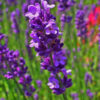**The Enchanting History of Purple Lavender Flowers**

Lavender, with its delicate purple hue and captivating fragrance, has enchanted humanity for centuries. Originating from the Mediterranean region, this aromatic herb has a rich history intertwined with various cultures and civilizations. Let’s embark on a journey through time to explore the fascinating history of the purple lavender flower.
**Ancient Beginnings**
The story of lavender dates back thousands of years to ancient civilizations such as the Egyptians, Greeks, and Romans. These cultures revered lavender for its therapeutic properties and used it in religious ceremonies, bathing rituals, and as a natural perfume. Lavender’s name is derived from the Latin word “lavare,” meaning “to wash,” highlighting its association with cleanliness and purification.
**Medieval Europe**
During the Middle Ages, lavender became synonymous with love, purity, and devotion in Europe. It was commonly used in medieval gardens and monasteries for its aromatic qualities and medicinal benefits. Lavender-filled sachets were often placed in wardrobes and beds to repel moths and promote relaxation.
**Renaissance Revival**
The Renaissance era witnessed a resurgence of interest in lavender, particularly in the fields of medicine and aromatherapy. Renowned herbalists like John Gerard and Nicholas Culpeper extolled the virtues of lavender in their botanical writings, praising its ability to soothe headaches, alleviate stress, and induce sleep.
**Victorian Era Elegance**
In the 19th century, lavender reached the height of its popularity during the Victorian era. Lavish gardens adorned with lavender bushes became a symbol of elegance and refinement among the Victorian aristocracy. Lavender’s sweet fragrance permeated Victorian households, where it was used in potpourri, perfumes, and herbal remedies.
**Modern Cultivation**
Today, lavender continues to thrive as a beloved ornamental plant and essential oil crop worldwide. Lavender farms can be found in various countries, from France’s Provence region to the hills of New Zealand. Its versatile uses range from culinary delights such as lavender-infused honey and teas to therapeutic products like aromatherapy oils and skincare treatments.
**Cultural Significance**
Across different cultures, lavender holds symbolic significance beyond its aesthetic and aromatic appeal. It is often associated with tranquility, healing, and spiritual purification. Lavender’s timeless allure transcends borders, making it a cherished botanical treasure cherished by people of all ages and backgrounds.
**Conclusion**
The journey of lavender through history is a testament to its enduring allure and timeless charm. From ancient civilizations to modern-day enthusiasts, the purple lavender flower continues to captivate hearts and minds with its beauty and fragrance. As we celebrate its rich heritage, let us embrace the magic of lavender and revel in its soothing embrace for generations to come.

